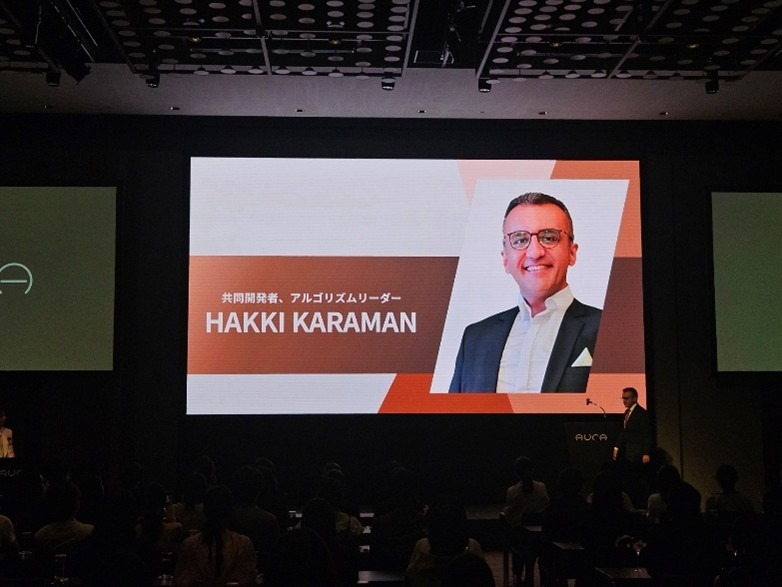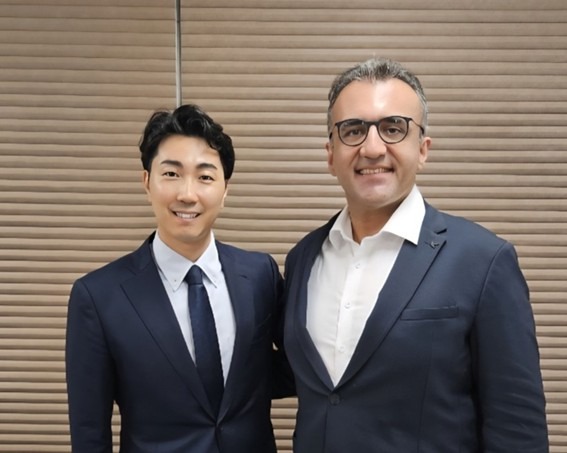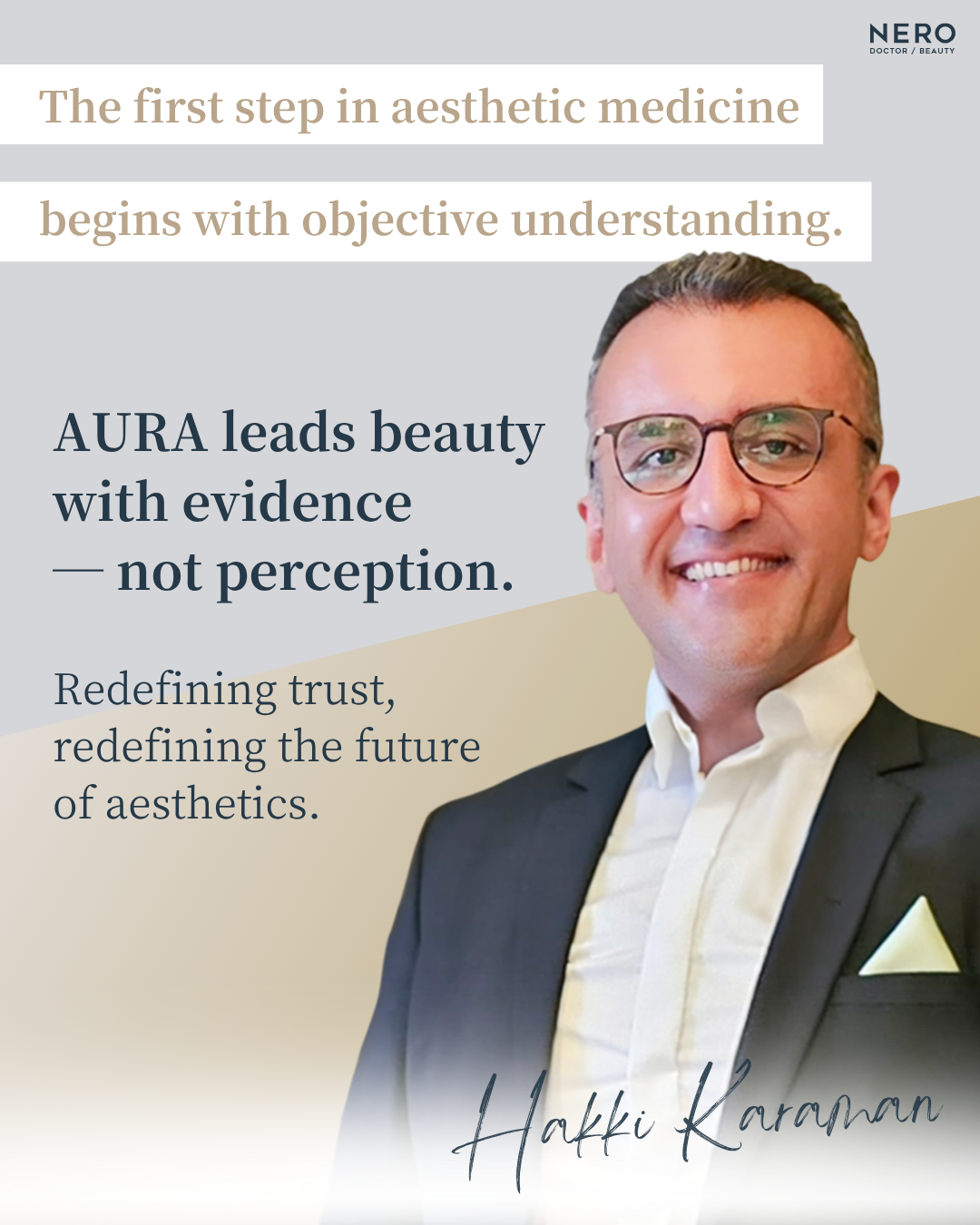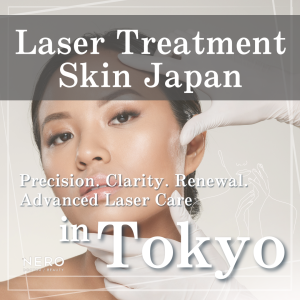
We sat down with Hakki Karaman, co-inventor of the cutting-edge 3D face and neck analysis system (that analysis 3D face morphology and skin metrics) AURA.
This next-generation imaging system captures the face and neck in a single click, visualizing even 0.1mm differences before and after treatment.
During its launch seminar on September 7, 2025, AURA drew intense attention from professionals across the aesthetic medicine field.
In this exclusive interview, we speak with Hakki Karaman, AURA’s co-inventor and head of algorithm development, to explore the story behind its development and his vision for the future of beauty technology.
INDEX
- Profile
- Editor’s Report: The Excitement at the AURA Launch Seminar — Captivating the Audience from the Moment of Unveiling
- The Story Behind AURA — Capturing Subtle Differences that Matter
- The Precision of AURA — Delivering Confidence by Visualizing 0.1mm Differences
- Designed for Ease — As Intuitive as Using an Apple Product
- How AURA Transforms Clinical Practice — Clearer Communication with Patients
- Looking Ahead — Building a “Universal Language” for Aesthetic Diagnosis
- A Message to Readers — From Intuition to Evidence: A New Era of Beauty
Profile
Co-inventor of AURA Skin Analysis Device
Hakki Karaman
Born in Turkey and based in Zurich, Switzerland, Hakki Karaman is a mathematician with an interdisciplinary background that spans mechanical engineering, mathematics, fluid dynamics, landscape architecture, and Management, Technology & Economics (MTEC).
He studied at world-renowned institutions including ETH Zurich, École Polytechnique in Paris, and Boğaziçi University in Istanbul.
With over a decade of experience in advancing 3D computer vision and photogrammetry systems, he has contributed to a wide range of innovation-driven projects.
At Hexagon, Karaman led the algorithm development of AURA as its co-inventor, applying his cross-disciplinary expertise in AI, robotics, and visualization to the field of medical aesthetics.
His work has also received recognition from international product design awards.
| 【Career】 2010 – Earned dual bachelor’s degrees in Mechanical Engineering and Mathematics from Boğaziçi University (Istanbul) 2012 – Obtained a Master’s degree in Fluid Dynamics from École Polytechnique (Paris) 2015 – Conducted PhD research in Elastic Wave Propagation at the Institute of Geophysics, ETH Zurich, co-authored three scientific papers before switching his focus to 3D Computer Vision innovation. 2016 – Obtained a MAS in Landscape Architecture at ETH Zurich, specializing in urban mapping and photorealistic 3D digital twins 2020 – Served as an R&D Engineer at the Swiss high-tech startup Nomoko, where he co-developed 3D computer vision and photogrammetry systems. 2021 – Worked as an R&D Engineer at CERN, conducting research on two-phase CO₂ flow and developing Computer Vision (CV) and Machine Learning (ML) applications. Joined Hexagon as Algorithm Lead, co-developing AURA 3D Imaging System and overseeing its algorithm design. 2023 – Completed a MAS in Management, Technology & Economics (MTEC) at ETH Zurich, focusing on technology entrepreneurship, innovation management, leadership, and strategic technology marketing. |
Editor’s Report: The Excitement at the AURA Launch Seminar — Captivating the Audience from the Moment of Unveiling

On September 7, 2025, leading practitioners from across Japan gathered at the Grand Hyatt Tokyo for the unveiling of AURA.
On stage were Atsumasa Yoshida, President of distributor INFIX, and several renowned doctors from top aesthetic clinics.
But the spotlight was on Hakki Karaman, whose presentation captivated the audience.

(NERO Editor-in-Chief & CEO Kenichi Adachi)
“Using photogrammetry technology, AURA captures both the face and neck in three-dimensional and two-dimensional perspectives — simultaneously,”
said Karaman, drawing gasps of surprise from the crowd.
The ability to achieve clinical-grade imaging without massive hardware or lengthy processing was recognized as a true breakthrough.
Attendees were quick to praise the device, noting how it would enable a new level of diagnostic precision.
Following the event, the NERO editorial team conducted an exclusive interview to explore the technology and philosophy behind AURA — and what it means for the future of aesthetic medicine.
The Story Behind AURA — Capturing Subtle Differences that Matter

— What inspired you to develop AURA?
In aesthetic medicine, even the smallest changes can alter how someone looks and feels.
Take filler injections, for example — a difference of just 0.5cc can dramatically change facial balance.
However, standard photographs often fail to convey those changes clearly.
Patients might say, “I think it looks better, but I can not quite tell.” We wanted to eliminate that ambiguity.
By capturing the face in three dimensions, we realized we could visualize those subtle differences precisely.
The human face is inherently three-dimensional — only when that depth is understood can the true results of a treatment be shown objectively.
That was the core idea behind incorporating 3D technology into AURA.
The Precision of AURA — Delivering Confidence by Visualizing 0.1mm Differences

— AURA can detect differences as small as 0.1mm. Why was such precision important?
Patient satisfaction often depends on how clearly those small improvements can be demonstrated.
By color-mapping changes such as wrinkle depth, lift direction, or volume differences on a heat map, patients can see where improvements occurred.
For doctors, it also enables quantitative explanations instead of relying solely on intuition or words.
— How does AURA differ from conventional diagnostic imaging?
Traditional 2D images are heavily influenced by lighting and angles, which makes accurate comparisons difficult. AURA, by contrast, standardizes all imaging conditions — capturing before-and-after differences with clinical precision.
Instead of “I think it changed,” patients can say, “I can clearly see the difference.”
That clarity builds trust and confidence between patient and doctor.
Designed for Ease — As Intuitive as Using an Apple Product
— Usability is key in clinical environments. How did you address that?
Our goal was “one-click simplicity.”
AURA requires no darkroom or special setup.
It is instantly ready to use. Inside the compact frame are 13 cameras and 18 light sources, engineered to minimize the influence of external lighting.
Patients do not need their heads fixed in place — they simply align with an on-screen guide.
No matter who operates it, the results remain consistent.
That is a major advantage for busy clinics.
— Some say it feels like using an Apple product. Was that intentional?
Absolutely. AURA was designed to be intuitive for anyone to operate.
We believe that making it usable without any specialized knowledge is key to ensuring it becomes a long-term tool in clinical practice.
In fact, many clinics use Apple products, so we paid close attention not only to functionality but also to aesthetics and design harmony.
AURA features a compact, sophisticated form that can easily be carried between rooms.
It is also the only aesthetic imaging system to receive the international iF Design Award, a recognition of both its innovation and visual excellence.”
How AURA Transforms Clinical Practice — Clearer Communication with Patients
— What kind of impact does AURA have on everyday practice?
First, it reduces the burden of explanation for doctors.
Instead of saying “it looks better,” they can show measurable, color-coded proof of change.
Patients understand their results visually and intuitively — which naturally builds trust and satisfaction.
Many even start discussing next steps, such as adding a lift or filler, as they gain confidence in their progress.
— Are there practical benefits for doctors as well?
Definitely. It shortens consultation time and ensures consistent record-keeping.
Since all data is stored, doctors can track long-term results accurately, improving follow-up care and continuity.
Looking Ahead — Building a “Universal Language” for Aesthetic Diagnosis

— How do you envision AURA shaping the future of aesthetic medicine?
Our ultimate goal is to establish a “universal diagnostic language.”
Imagine a patient’s AURA report taken in Japan being evaluated by a doctor in France — using the same objective criteria.
Aesthetic outcomes are often described subjectively, varying across cultures and practitioners.
By defining clear, quantitative standards, AURA can enhance global collaboration and patient confidence.
— So, AURA could shape the future of standardized evaluation?
Exactly. AURA generates 3D models, calculates scores, and applies standardized definitions.
In the future, patients could bring their own AURA data when receiving treatment abroad, allowing doctors worldwide to assess results using the same framework.
That vision is not far away.
— And how about technological evolution?
3D computer vision is advancing at an incredible pace, largely driven by industries like gaming and film.
The same innovations that make virtual worlds more realistic are now transforming medical imaging.
AURA undergoes multiple software updates each year, incorporating new research and user feedback.
We will continue refining it in response to medical needs — innovation is an ongoing journey.
A Message to Readers — From Intuition to Evidence: A New Era of Beauty

— What message would you share with clinics considering AURA?
AURA is a technology that opens the future.
For clinics already using it, I encourage you to keep your software updated and make the most of it in daily practice.
For those still considering, adopting AURA early will be a major advantage.
In a few years, it will likely become the industry standard.
Taking that first step now means offering your patients even greater value and trust.
— And for patients exploring aesthetic treatments?
The first step in beauty medicine is understanding your “now.”
AURA lets you visualize your skin and facial contours under identical conditions before and after treatment.
This gives you clarity and confidence in your choices.
Aesthetic medicine is no longer exclusive — it is accessible to everyone, in their own way.
Clinics adopting new technologies like AURA can offer more transparency, choice, and comfort to every patient.
It is more than a diagnostic tool — it is a bridge between science and beauty. We invite you to experience it for yourself.







